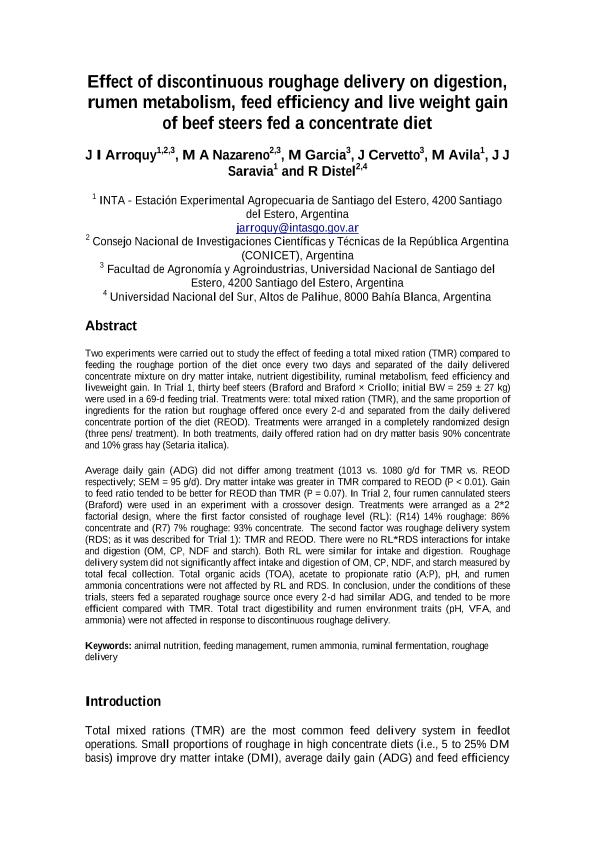Artículo
Effect of discontinuous roughage delivery on digestion, rumen metabolism, feed efficiency and live weight gain of beef steers fed a concentrate diet
Arroquy, Jose Ignacio ; Nazareno, Mónica Azucena
; Nazareno, Mónica Azucena ; García, Elisa Mariana
; García, Elisa Mariana ; Cervetto, Juan Jose; Avila, M.; Saravia, J. J.; Distel, Roberto Alejandro
; Cervetto, Juan Jose; Avila, M.; Saravia, J. J.; Distel, Roberto Alejandro
 ; Nazareno, Mónica Azucena
; Nazareno, Mónica Azucena ; García, Elisa Mariana
; García, Elisa Mariana ; Cervetto, Juan Jose; Avila, M.; Saravia, J. J.; Distel, Roberto Alejandro
; Cervetto, Juan Jose; Avila, M.; Saravia, J. J.; Distel, Roberto Alejandro
Fecha de publicación:
05/2012
Editorial:
Centro para la Investigación en Sistemas Sostenibles de Producción Agropecuaria
Revista:
Livestock Research For Rural Development
ISSN:
0121-3784
e-ISSN:
2521-9952
Idioma:
Inglés
Tipo de recurso:
Artículo publicado
Clasificación temática:
Resumen
Two experiments were carried out to study the effect of feeding a total mixed ration (TMR) compared to feeding the roughage portion of the diet once every two days and separated of the daily delivered concentrate mixture on dry matter intake, nutrient digestibility, ruminal metabolism, feed efficiency and liveweight gain. In Trial 1, thirty beef steers (Braford and Braford × Criollo; initial BW = 259 ± 27 kg) were used in a 69-d feeding trial. Treatments were: total mixed ration (TMR), and the same proportion of ingredients for the ration but roughage offered once every 2-d and separated from the daily delivered concentrate portion of the diet (REOD). Treatments were arranged in a completely randomized design (three pens/ treatment). In both treatments, daily offered ration had on dry matter basis 90% concentrate and 10% grass hay (Setaria italica). Average daily gain (ADG) did not differ among treatment (1013 vs. 1080 g/d for TMR vs. REOD respectively; SEM = 95 g/d). Dry matter intake was greater in TMR compared to REOD (P < 0.01). Gain to feed ratio tended to be better for REOD than TMR (P = 0.07). In Trial 2, four rumen cannulated steers (Braford) were used in an experiment with a crossover design. Treatments were arranged as a 2*2 factorial design, where the first factor consisted of roughage level (RL): (R14) 14% roughage: 86% concentrate and (R7) 7% roughage: 93% concentrate. The second factor was roughage delivery system (RDS; as it was described for Trial 1): TMR and REOD. There were no RL*RDS interactions for intake and digestion (OM, CP, NDF and starch). Both RL were similar for intake and digestion. Roughage delivery system did not significantly affect intake and digestion of OM, CP, NDF, and starch measured by total fecal collection. Total organic acids (TOA), acetate to propionate ratio (A:P), pH, and rumen ammonia concentrations were not affected by RL and RDS. In conclusion, under the conditions of these trials, steers fed a separated roughage source once every 2-d had similar ADG, and tended to be more efficient compared with TMR. Total tract digestibility and rumen environment traits (pH, VFA, and ammonia) were not affected in response to discontinuous roughage delivery.
Archivos asociados
Licencia
Identificadores
Colecciones
Articulos(SEDE CENTRAL)
Articulos de SEDE CENTRAL
Articulos de SEDE CENTRAL
Citación
Arroquy, Jose Ignacio; Nazareno, Mónica Azucena; García, Elisa Mariana; Cervetto, Juan Jose; Avila, M.; et al.; Effect of discontinuous roughage delivery on digestion, rumen metabolism, feed efficiency and live weight gain of beef steers fed a concentrate diet; Centro para la Investigación en Sistemas Sostenibles de Producción Agropecuaria; Livestock Research For Rural Development; 24; 5; 5-2012; 1-13
Compartir



